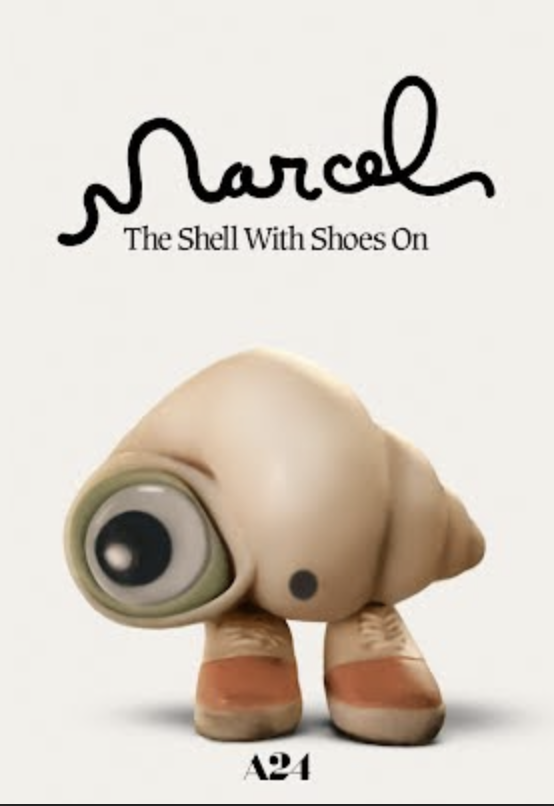Little Shell, Big Heart: A Review on Marcel the Shell With Shoes On.
June 15, 2023
On Monday, the Oscars’ red carpet featured an unlikely guest. Standing at one inch tall was the Academy Awards’ smallest big star: Marcel the Shell With Shoes On. In his charming top hat and (of course) shoes, the 2023 Oscar nominee had Hollywood’s biggest celebrities squatting for selfies and autographs. More than just a cute character, Marcel takes a uniquely melancholy and unexpectedly emotional approach to capturing the hearts of viewers in Marcel the Shell With Shoes On, a film. As the first-person-documentary style cinematography invites viewers to shrink down into Marcel’s world, his childlike optimism and determination transport the audience to the joys of a simplistic life.
Thirteen years ago, before his fame and glamor, Marcel’s character humbly originated in a claustrophobic hotel room. In an anxious spur, Jenny Slate, sitting with her now ex-husband Dean Fleischer Camp, burst out in a falsetto-sounding animated voice. At this moment, Slate had unknowingly created Marcel and a signature aspect of his appeal: his adorable voice. With materials lying around, Fleischer Camp, recognizing the draw of the voice, constructed a shell figurine to embody Slate’s character, soon known as Marcel. On October 16, 2010, Marcel made his internet debut in a 3-minute YouTube clip which has now generated over 30 million views.
In the years following, Marcel graduated from a YouTube project into a major motion film. In the 90-minute motion feature, Fleischer Camp’s “documentary” takes viewers on an endearing adventure about what it means to be small in a big world, stressing that no matter how insignificant we may feel, with help and love from others, no task is too big.
According to Marcel, “It’s pretty much common knowledge that it takes at least twenty shells to have a community.” But, after a mysterious sock-drawer-packing tragedy leaves Marcel (Jenny Slate) and his grandmother Connie (Isabella Rossellini) separated from the rest of their family, the once thriving shell community of a California Air-Bnb appears to be lost forever. Thankfully, when up-and-coming documentary maker Dean (Dean Fleischer Camp) takes on Marcel as his newest film project, Dean’s successful YouTube videos of Marcel (an allusion to Marcel’s real-life internet popularity) begin to close the seemingly impossible gap between Marcel and his family.
Despite its simplistic plot, Marcel’s “cute factor,” in both his voice and appearance, is so adorable to some theatergoers they can’t help but cry at his endearing moments of rambling and contemplation. Admittedly, I found myself inexplicably teary-eyed as Marcel waddled with his “lint pet” into the frame. I eventually gave in to a full stream of happy tears at the sight of Marcel’s reunited community watching YouTube together. With Marcel’s unique emotional appeal, in a society of consistent uncertainty and stress, it’s no wonder that this 90-minute serotonin-filled escape racked up an impressive 100 percent Rotten Tomatoes rating, according to MovieWeb, following its debut on June 24, 2022.
Reflective of these ratings, Marcel has since been nominated for over a dozen major awards, many of which praised the movie’s unique and carefully executed cinematography. According to an interview conducted by Sean Hayes with Slate, Marcel the Shell With Shoes On took seven years to film, a level of precision reflected in the seamlessness of the stop-motion animation. Animation Director Kirsten Lepore creates an experience so immersive you may even forget a world without talking shells exists. Nonetheless, Lepore leaves Marcel’s simplistic figure unaltered to maintain his organic and natural feel that has had people classifying Marcel as their ‘comfort character’ for over a decade.
In an interview with TODAY, Fleischer Camp expressed his hopes for audiences to leave the theater “a little kinder, a little more willing to be gentle with one another.” Successful in this goal, Marcel’s childlike positivity resonates with young viewers and serves as a nostalgic escape for adults. While exiting the theater, viewers of all ages walk away with a noticeable extra pep in their step, some even holding the hands of the people they came in with a little tighter.


























